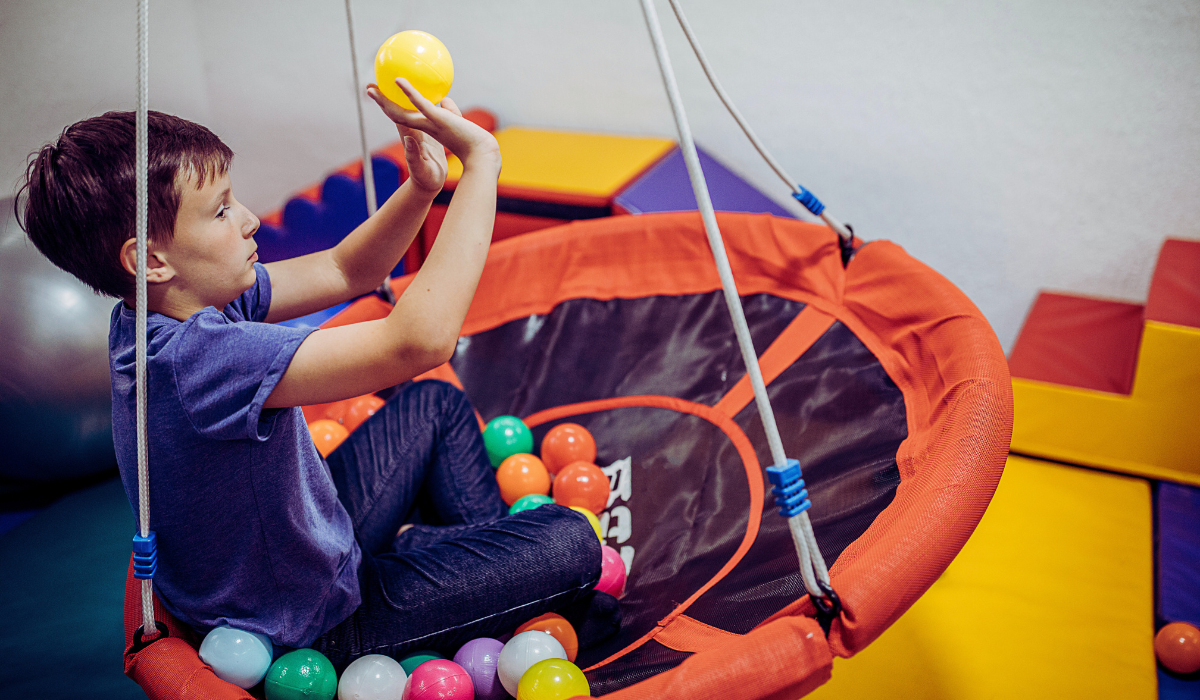People with Sensory Processing Disorder have difficulty processing sensory information and responding appropriately to that information. Sometimes sensory processing difficulties are seen as noncompliance or bad behavior. This can result in problems with behavior, social participation, self-regulation, and impaired skills for daily life tasks.
- Be sure to visit our Behavior Resources webpage for more resources.
What is sensory processing?
Sensory processing is the way the nervous system receives and interprets information from all of our senses. People take in sensations/messages through their five primary senses: sight, hearing, taste, touch and smell. We also take in and process sensory information through our muscles, joints, skin and inner ears. These are called vestibular senses (balance and motor skills) and proprioceptive senses (body awareness).
For most people, sensory processing happens automatically. People with Sensory Processing Disorder (SPD) may be over-sensitive or under-sensitive to sensory input, making it difficult to regulate their behavior and emotions. This sensory sensitivity can mean certain sensations are overwhelming or even painful. Or they might seek out certain sensory experiences.
What do sensory processing issues look like at school?
Overwhelming or underwhelming sensory input can lead to a variety of behaviors in children, especially at school. Every child with SPD is unique, and may exhibit different behaviors depending on their individual sensory challenges. If you suspect that your child may have SPD, it is important to start with an evaluation to get proper supports.
This might look like:
- Struggling to transition from one activity to another
- Avoiding certain activities or places due to sensory triggers or overload
- Bothered by certain textures, sounds, smells, etc
- Sensory seeking behavior, such as touching everything or being too rambunctious
- Fine motor difficulties such as writing or using scissors, or clumsiness
- Social interaction struggles like outbursts, avoidance, not making eye contact, not understanding social cues
How do you get an IEP for sensory issues?
The Michigan Administrative Rules for Special Education (MARSE) define eligibility for special education services within thirteen categories of disability. Sensory Processing is not it’s own category, but sensory processing is a factor that may contribute to a child’s difficulties in school.
Sensory processing can be a stand alone concern, or it may be a characteristic of another disorder. If your child is struggling with sensory issues, and they don’t currently receive special education services, the first step is to request an evaluation from their school. This evaluation will help determine if they have a disability that qualifies for an IEP and what services and accommodations they might need to succeed at school.
If your child already has an IEP, check to see what is included in the current Present Level of Academic Achievement and Functional Performance (PLAAFP) statement about sensory needs or concerns. The PLAAFP must address all of the student’s identified needs, not just ones directly related to the category for which they are eligible for special education services. If you believe your child may have sensory processing difficulties, it is important to speak with the IEP team to discuss your concerns and request an evaluation.
What needs to go in the IEP?
With the right support and accommodations, your child can succeed in school and beyond. There are strategies and therapies available to help people with sensory processing difficulties.
Some problematic behaviors may come from too much sensory stimulation such as bright lights, strong smells, loud or irritating noises, or uncomfortable clothing. This may be addressed with changes to the environment, accommodations for the child, or gradually teaching the child to tolerate the sensory input.
Some children seek out more sensory input and engage in behaviors like jumping, spinning, finger flicking, pacing, rocking, banging, or other behaviors that give sensory stimulation. It is important to work with your school team to identify ways to help a child regulate and get the input they need in a safe way that minimizes interference with learning and social interactions.
If the reasons behind a behavior are not clear or problems are escalating, you can request a functional behavior assessment to better determine what is triggering a problematic behavior. By understanding what is causing the behavior, support strategies can be put in place to assist the student.
Who diagnoses a sensory processing disorder?
A diagnosis of SPD is typically made by a qualified healthcare professional, such as an occupational therapist, a pediatrician, or a neurologist. Sensory processing difficulties may be associated with another diagnosis, including autism, ADHD, and anxiety disorders. A sensory assessment by the school’s occupational therapist (OT) can help define the sensory concerns in school and ways to help.
The specific tests used to evaluate SPD vary depending on the individual child’s needs and the evaluation team’s preferences. Sensory assessments can help to identify specific sensory processing patterns, such as under-responsiveness, over-responsiveness, and sensory-seeking behavior. This data can then be used to create an individualized plan to support the child’s learning and development. When parents and schools have a better understanding of how SPD is impacting the student at school, those needs can be addressed.


